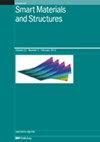保形条件对聚氨酯-形状记忆聚合物泡沫塑料形状恢复的影响
IF 3.7
3区 材料科学
Q1 INSTRUMENTS & INSTRUMENTATION
引用次数: 0
摘要
实验研究了聚氨酯-形状记忆聚合物(SMP)泡沫材料的热力学性能以及保形条件对形状恢复的影响。所得结果可总结如下。(1)在高于Tg的压缩变形后,将泡沫冷却至玻璃化转变温度Tg以下,应力减小,变形形状固定。在空载条件下,将固定形状的泡沫加热至Tg以上,可恢复其原始形状。(2)在Tg−60 K的空载条件下,不依赖于最大应变,Tg以上变形的形状可以保持6个月,之后通过加热恢复到原来的形状。(3)如果在高温下保持变形的形状,则不能恢复原来的形状。(4)形状不恢复率随保温应变、保温温度和保温时间的增加而增大。本文章由计算机程序翻译,如有差异,请以英文原文为准。
The influence of shape-holding conditions on shape recovery of polyurethane-shape memory polymer foams
The thermomechanical properties of polyurethane-shape memory polymer (SMP) foams and the influence of shape-holding conditions on shape recovery were investigated experimentally. The results obtained can be summarized as follows. (1) By cooling the foam down to below the glass transition temperature Tg after compressive deformation above Tg, stress decreases and the deformed shape is fixed. By heating the shape-fixed foam up to above Tg under no load, the original shape is recovered. (2) The shape deformed above Tg is maintained for six months under no load at Tg− 60 K without depending on the maximum strain, and the original shape is recovered by heating thereafter. (3) If the deformed shape is held at high temperature, the original shape is not recovered. (4) The ratio of shape irrecovery increases in proportion to the holding strain, holding temperature and holding time.
求助全文
通过发布文献求助,成功后即可免费获取论文全文。
去求助
来源期刊

Smart Materials and Structures
工程技术-材料科学:综合
CiteScore
7.50
自引率
12.20%
发文量
317
审稿时长
3 months
期刊介绍:
Smart Materials and Structures (SMS) is a multi-disciplinary engineering journal that explores the creation and utilization of novel forms of transduction. It is a leading journal in the area of smart materials and structures, publishing the most important results from different regions of the world, largely from Asia, Europe and North America. The results may be as disparate as the development of new materials and active composite systems, derived using theoretical predictions to complex structural systems, which generate new capabilities by incorporating enabling new smart material transducers. The theoretical predictions are usually accompanied with experimental verification, characterizing the performance of new structures and devices. These systems are examined from the nanoscale to the macroscopic. SMS has a Board of Associate Editors who are specialists in a multitude of areas, ensuring that reviews are fast, fair and performed by experts in all sub-disciplines of smart materials, systems and structures.
A smart material is defined as any material that is capable of being controlled such that its response and properties change under a stimulus. A smart structure or system is capable of reacting to stimuli or the environment in a prescribed manner. SMS is committed to understanding, expanding and dissemination of knowledge in this subject matter.
 求助内容:
求助内容: 应助结果提醒方式:
应助结果提醒方式:


